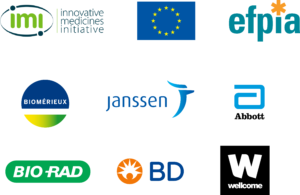WP2 encompasses microbiology work performed on clinical samples obtained from WP4 clinical trials, as well as biobanking. As the clinical trials have not started yet, no actionable results have been obtained so far. However, the WP2 team has been working on the optimization of the methods to be used once the samples are received.
Specifically, work has been performed on the aetiology elucidation from clinical samples based on next generation sequencing (NGS) techniques. Especial focus has been put into the detection of Streptococcus pneumoniae from clinical samples as one of the primary pathogens causing CA-ARTI, but other pathogens, such as viruses, will also be detected. Furthermore, work has been performed on direct detection of antimicrobial resistance (AMR) in bacterial pathogens by correlating phenotypic and genotypic data. This will allow to predict AMR directly from raw sequencing data.
The WP2 team has collected publicly available and in-house generated S. pneumoniae WGS sequences and built a Hidden Markov Model (HMM) based serotyping database for S. pneumoniae. This in-house developed database will be used along with phenotypic data, which will enable us to delineate and identify the serotypes, especially novel serotypes, from metagenomics data. This database, the first of its kind for S. pneumoniae, will be made publicly available in the near future.
All these methods will be applied in the metagenomics study, which allows defining the microbial community present in a sample, as well as studying the resistome, that is the whole set of antimicrobial resistance genes present in that sample. The clinical trial has not started yet, but the optimization of this protocol is ongoing. The protocol to perform shotgun metagenomics on a short-read sequencing platform (Illumina MiSeq) is optimized, while the protocol for long-read 16S sequencing (PacBio Sequel) is almost complete.
Additionally, work is undergoing for the development of the bioinformatics pipeline to be used to remove host DNA and analyze the sequencing results. This pipeline includes a first step to removing host reads, and then several analyses are performed (assembly of the metagenome, detection of antimicrobial resistance genes and virulence factors, the taxonomic classification of the bacterial community).
Biomarker detection will proceed by mesoscale discovery (MSD) wherein the instrument is available and the protocols are being optimized. Research will begin when clinical samples are received.
Biobanking will be the next step.


